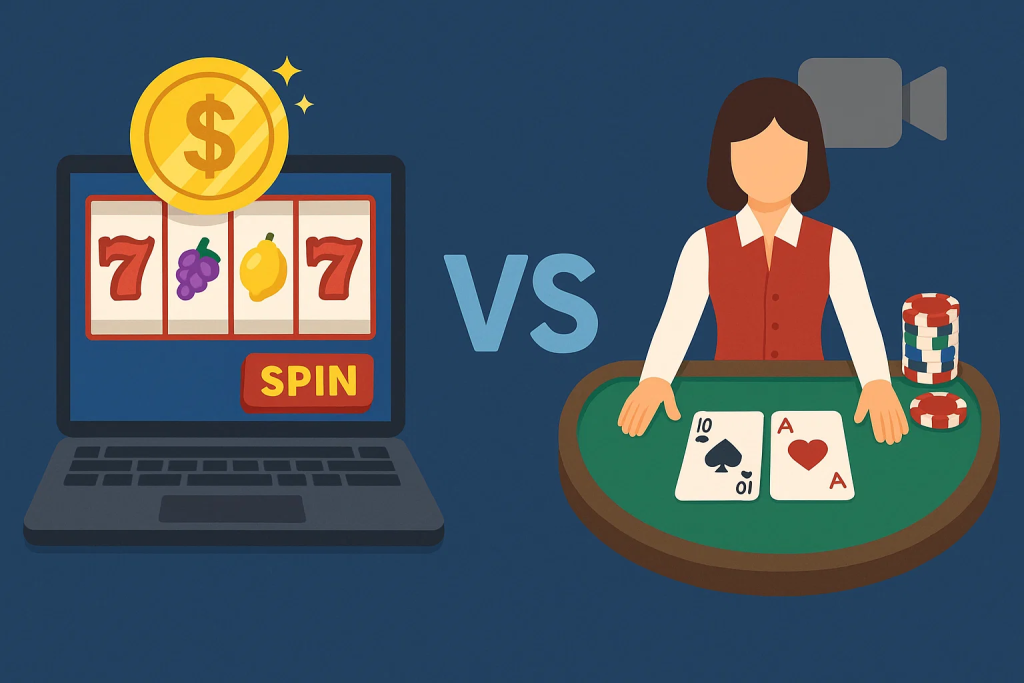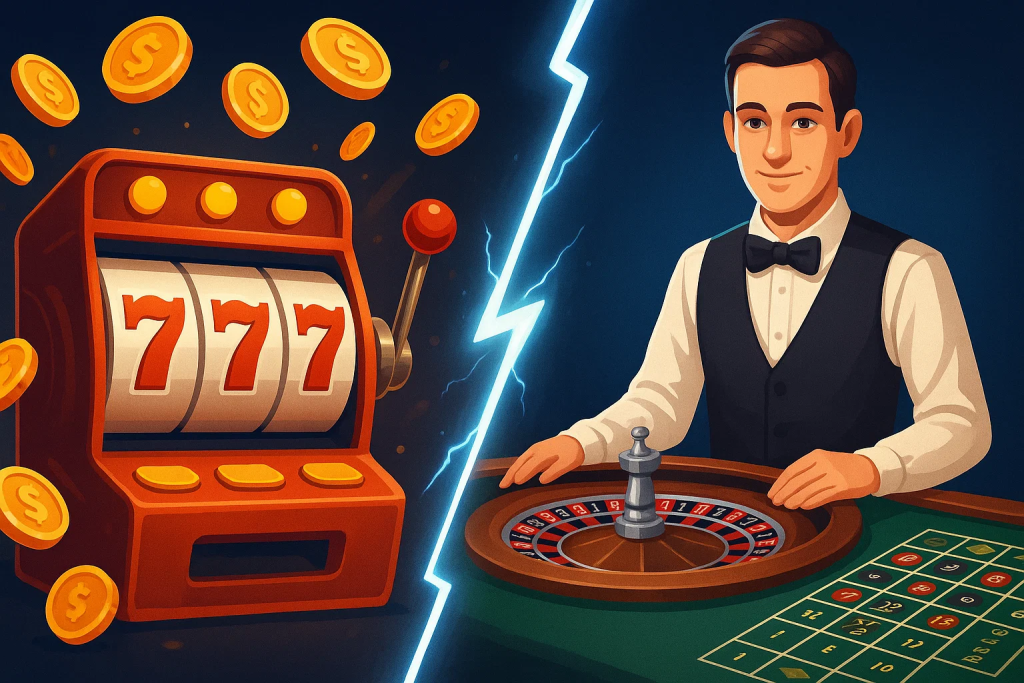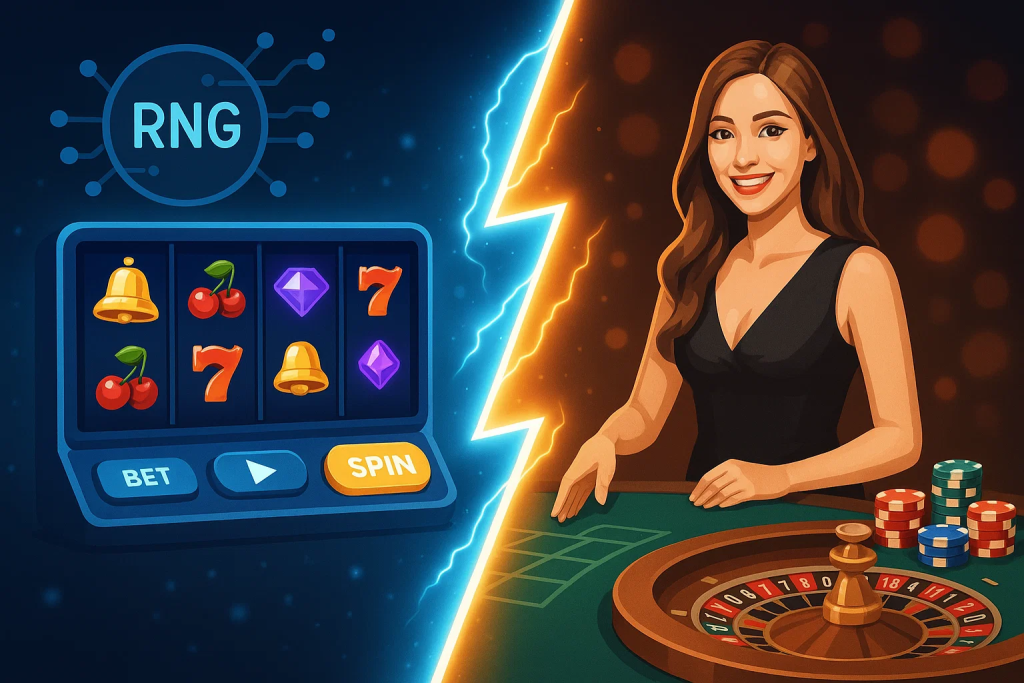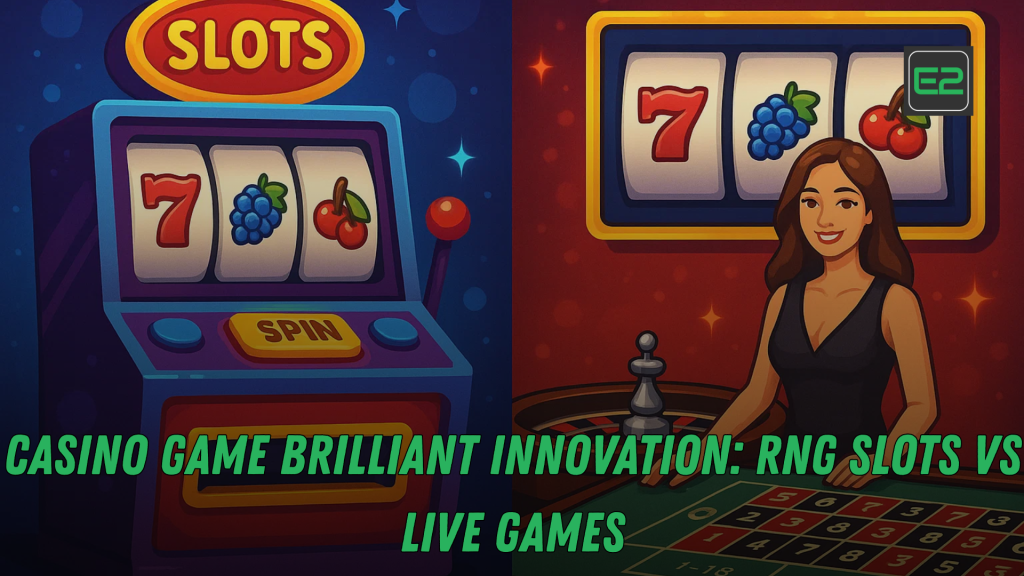Table of Contents
Why This Debate Matters Now
If you’ve spent time in a modern iGaming lobby, you’ve felt the split: on one side, RNG Game slots—fast, varied, endlessly creative. On the other side, live dealer games—social, cinematic, and increasingly game-show-like. Both formats are popular; both claim innovation; both promise “fairness.” But they deliver very different experiences, and your enjoyment, session length, and bankroll swings depend on knowing exactly what you’re choosing.
This guide demystifies the mechanics and the psychology behind each format, then puts practical tools in your hands—clear definitions, math you can use, budget models, decision frameworks, and real-world tips for players, creators, and product teams. No hype, just clarity.

Plain-English Definitions
RNG Slots (Random Number Generator slots):
Digital slot games (including megaways, cluster pays, hold-and-spin, crash/instant games, and RNG table variants) where a certified random number generator maps each round’s random output to the symbols or results you see. Each round is independent—what happened before doesn’t change the probabilities of the next spin.
Live Casino Games:
Real dealers (or automated physical devices) streamed from professional studios or casino floors. Think blackjack, roulette, baccarat, and live game shows with wheels, dice, and presenter-led bonus events. Many modern live titles add RNG-driven multipliers to physical outcomes, blending the two worlds.
How RNG Slots Actually Work
Randomness, RTP, and Volatility—Three Concepts to Anchor Your Expectations
Randomness (the RNG):
A tested algorithm produces an unpredictable number (or sequence) for each round. That number maps to reel stops, symbol grids, or instant-game multipliers. There’s no “memory.” A cold streak isn’t a setup for a hot streak; it’s just randomness clustering.
Return to Player (RTP):
RTP is a long-term statistical expectation—for example, 96% RTP means that across millions of rounds, 96% of total wagered is returned to players as wins, 4% is retained by the house as edge. It’s not a promise for your session, which can deviate wildly.
Volatility (variance):
Low-volatility games hit often with small prizes; high-volatility games hit less often with larger payouts. Volatility is the main driver of emotional texture—how your session feels minute to minute. If you want steady engagement, pick lower variance. If you enjoy suspense and the possibility of spikes, you’ll gravitate to higher variance.
Feature Design That Powers Modern Slots
- Megaways and ways-to-win: Reels shift in height; the number of possible combinations explodes. This spreads outcomes and makes bonuses feel more dynamic.
- Cluster pays: Matches form anywhere in a grid; cascades create multi-hit sequences from a single buy-in.
- Persistent states: Collectibles, meters, and sticky wilds create continuity between base game and bonus.
- Bonus buys and super modes (where permitted): Pay a premium to jump straight to feature rounds—great for content creation but costly if you don’t manage risk.
- Hold-and-spin and cash-on-reels: Clear, countable math with suspenseful retriggers.
- Crash/instant games: Minimalist UI, transparent multipliers, and clear risk timing; still governed by RNG, simply packaged differently.
Common Myths—Debunked
- “It’s due to pay.” An RNG game is never “due.” Probability doesn’t keep a ledger.
- “Bet size changes RTP.” In regulated titles, the operator may choose an RTP setting at integration, but your bet size inside a session doesn’t change the game’s theoretical return.
- “They flip a switch mid-session.” In regulated environments, game math and RNG are certified against exactly that kind of interference.
How Live Casino Really Works
The Live Stack—From Studio to Screen
- Studios and production: Multiple cameras, broadcast-grade lighting, pro audio, stage management, and monitoring rooms that enforce dealing procedures and integrity.
- Physical randomization: Real cards, wheels, and dice; automated shufflers and wheels ensure pace and consistency.
- Computer vision and sensors: Systems read the physical outcome (e.g., roulette number) and map bets instantly.
- Low-latency streaming: Modern delivery keeps delay minimal, so you experience the round in near-real time.
Live Innovation You’ll Notice
- Presenter-led game shows: Human hosts, interactive side games, and big-moment pacing.
- Multiplier fusion: Traditional tables (roulette, baccarat, blackjack) enhanced with random boosted payouts on specific numbers, cards, or hands. The base is physical; the multiplier layer is RNG.
- Bet behind / shared seats: Everyone can participate even when the main seats are full.
- Squeeze, reveals, and camera choreography: Tension is a mechanic; reveal control is part of the fun.
- Virtual sets and AR: The stage becomes a canvas; results and multipliers animate around the presenter.
Live vs RNG—Different Roots, Same Need for Trust
Live games rely on physics and transparent procedure; RNG slots rely on certified algorithms. In both cases, integrity lives in licensing, testing, and clear rules. The format you choose should come down to the experience you prefer, not to unfounded fears about fairness.
Experience Showdown: Speed, Social Energy, and Session Feel
Speed:
- RNG slots let you decide the rhythm: tap-by-tap, auto-spin, turbo. More rounds/hour means more excitement—but also a faster expected burn if you don’t throttle pace.
- Live games are naturally slower. Fewer rounds can make bankroll feel more durable.
Social energy:
- RNG is usually solo, though tournaments and community jackpots add some shared moments.
- Live is social by design: presenter banter, chat, shared cheering. It’s closer to TV than to a calculator.
Volatility delivery:
- RNG can deliver ultra-spiky, high-potential features or comfy low-variance grinds.
- Live spreads variance across fewer rounds; single outcomes (like a boosted roulette number) can still spike.
Learning curve:
- RNG requires almost none. Pick volatility and theme; spin.
- Live requires rules knowledge. Blackjack basic strategy, roulette bets, baccarat etiquette, side bets—worth learning if you enjoy mastery.
The Math You Can Use Today
A simple tool to plan your entertainment is expected loss per hour: Expected loss/hour≈average bet×rounds per hour×house edge\text{Expected loss/hour} \approx \text{average bet} \times \text{rounds per hour} \times \text{house edge}Expected loss/hour≈average bet×rounds per hour×house edge
This isn’t a forecast for any given session; variance will bounce you above and below. It is a practical budgeting aid. If you want a 60-minute session and a comfortable expected spend, your choices are:
- Reduce the average bet
- Reduce rounds per hour (turn off turbo; play live tables)
- Choose games with a lower edge (or avoid high-tax side bets)
Armed with that equation, you can reverse-engineer a session to match your budget and mood.
Innovation Highlights: Where RNG Slots Shine
Mathematical storytelling:
Meters, collection trails, and multi-stage bonuses build narrative. You’re not just spinning; you’re “progressing.”
Agency (with guardrails):
Bonus buys, feature modes, and volatility toggles let you customize the ride. These are powerful—use with time and budget caps.
Crash and instant games:
Transparent odds presentations scratch the “show me the math” itch while keeping rounds quick.
Jackpot ecosystems:
Community progressives create social spikes in otherwise solo experiences. You’ll feel the “everyone holds breath” moment when a jackpot approaches must-drop logic or crosses a visible threshold.
Mobile-native UX:
Single-hand play, haptics, and thumb-zone interfaces let you enjoy short sessions seamlessly.
Personalization:
Smart lobbies surface games by volatility, theme, or session length, not just by “hotness.”
Innovation Highlights: Where Live Games Shine
Entertainment architecture:
Presenters are trained like TV hosts; pacing, music, and banter turn math into moments.
Multiplier fusion and side-game layers:
A base round stays classic; random boosts add modern suspense. When implemented transparently and responsibly, it blends the best of both worlds.
Co-viewing and creator-friendliness:
Live formats generate narratives you can follow: “we need two more rounds,” “last squeeze,” “one more spin.” Clips are naturally shareable without speeding the game up dangerously.
Inclusivity:
Bet behind and low minimums open the door to new players; advanced features remain optional rather than compulsory.
Integrity signals:
Camera angles, announced “no more bets,” and clear dealing procedures reassure skeptical newcomers.

Choosing the Right Format for Your Goal
- I want variety and high engagement per minute. Choose RNG slots with volatility that suits your budget.
- I want a slower, social session. Choose live dealer or game shows; keep side bets optional.
- I like strategy. Try live blackjack (learn basic strategy), roulette with disciplined bet sizing, or baccarat if you prefer simple decisions with ritual and pacing.
- I’m a content creator. Mix RNG (for quick highlights) with live (for audience interaction). Plan segments; don’t ad-lib your bankroll.
Bankroll and Time Management That Actually Works
1) Pre-commit a hard budget for the session—money you’re comfortable spending on entertainment.
2) Set a time box. Example: 45–60 minutes.
3) Convert your budget to units. If your budget is 100 units, bet 0.5–1.5 units on RNG spins, 1–2 units on live rounds.
4) Use speed brakes.
- In RNG: turn off turbo and auto-spin, or cap auto-spin counts.
- In live: skip side bets late in the session if you’re near budget.
5) Define a win condition. For instance, +20% of session budget; cash out if you hit it.
6) Use the tools. Deposit limits, time reminders, cool-offs—treat them as part of the product, not as defeat.
Creator’s Corner: Responsible and Watchable
- Open with transparency. State the budget, game plan, and volatility mix.
- Teach once per stream. For example, “We’ll show how cluster pays cascade,” or “Here’s how multipliers layer on a live wheel.”
- Show losses as well as wins. Credibility builds audiences.
- Segment the show. 20–30 minutes of RNG for highlights, then a live table for chat and decompression.
- Integrate safer-play messaging. Normalize limits the way fitness channels normalize warm-ups and cool-downs.
Operator & Product Team Playbook (High Level)
- Balance the lobby. Feature a rotating mix of proven RNG titles and curated live tiles; anchor each with “why play this” tags (volatility, complexity, session length).
- Compliance-led UX. RTP pages, reality checks, limit tools, and odds explanations deserve top-level visibility.
- Personalize by intent, not only spend. Match games to user-stated session length and volatility preference.
- Mobile performance. Sub-1-second feedback for RNG actions; smooth low-latency streaming for live.
- Health metrics. Track session completion within budget, not only ARPU. Reward teams for improving safe-play indicators.
- Educate at point of need. Micro-tooltips that explain side bets, volatility, and multipliers reduce confusion and impulse mistakes.
Psychology: Why They Feel So Different
RNG equals rapid feedback loops.
Lights, audio cues, quick outcomes—your brain gets a reward schedule with near-instant feedback. It’s engaging, which is why pacing tools are essential.
Live equals ritual and social proof.
The squeeze, presenter energy, chat reactions—the ritual builds anticipation. You’ll feel “part of something,” even at small stakes.
Illusions of control.
Choosing numbers or tables can feel more skillful; remember, the house edge is math, not mood. Pick formats for how you like to spend time, not because you believe one “pays better” by default.
Safety and Legitimacy Checklist
- Play only where licensed and tested. That’s where game math and RNG/live procedures are audited.
- Learn the house edge. Whether RNG or live, every game has expected cost over time.
- Know the myths. No “due” slot, no dealer vendetta, no private switch for your account.
- If it stops being fun, stop. Use time-outs, take breaks, or seek support services where you live.
The Hybrid Future: Trends to Watch
- RNG-powered multipliers on classic tables will keep expanding—physical round plus digital excitement.
- Presenter-style RNG shows will grow—no cards or wheels, but TV-like hosting around pure RNG math.
- Personal risk profiles within certified boundaries—players choose a “risk band,” and feature frequency adapts accordingly.
- Smarter nudges—session-aware prompts that suggest breaks or slower formats if your pace spikes.
- Spatial and haptic feedback that heightens presence without accelerating the game.
- Creator-mode lobbies that let audiences join safer, paced versions of what they’ve just watched—with safeguards built in.
Quick Decision Framework (Keep This Handy)
- Need spectacle and chat? Live game shows or live tables with friendly minimums.
- Need variety and quick highlights? RNG slots and instant games.
- Short budget, short time? Low-volatility RNG or low-stake live without side bets.
- Streaming tonight? Alternate 20 minutes of RNG highlights with 20 minutes of live conversation.
A 14-Day Improvement Plan (Players and Creators)
Days 1–3: Pick two games in your preferred format (one safe, one spiky). Log session length, average bet, and rounds/hour.
Days 4–6: Add the expected-loss formula to your planning. Nudge one variable lower (bet size, pace, or edge via side bets).
Day 7: Try the other format for contrast (RNG ↔ live). Journal how the session felt.
Days 8–10: Learn one rule deeper: blackjack basic strategy chart, roulette bet families, or slot volatility tags.
Days 11–12: Add a hard cap (number of spins or rounds). Respect it.
Day 13: Watch a replay or recall notes—what habit cost you the most? Speed? Side bets? Emotional chase?
Day 14: Run a “perfect discipline” session: pre-set budget, time box, no deviations. Enjoy how much calmer it feels.
What’s Next After POGO Ban: Casino-Legislation Brilliant Update
Strong Call-to-Action
Tell me your play style (fast spins or social tables), typical session length, and comfortable stake per round. I’ll reply with a custom mini-playlist—three RNG titles matched to your volatility preference, two live games matched to your pacing, and a one-page bankroll plan that uses the expected-loss formula so you get maximum fun without surprises.

Frequently Asked Questions
1) Which is “fairer”—RNG slots or live dealer games?
Both formats can be equally fair when they’re properly licensed and independently tested. RNG outcomes are generated by certified random number algorithms and mapped to game results.
Live dealer games rely on physical randomness—cards, wheels, dice—under strict procedures and camera coverage. Fairness rests on regulation and testing, not on whether the game is digital or physical.
2) Do live games pay better than slots?
Not by format alone. Each game’s house edge and rules determine long-term return. Many slots publish RTPs in the mid-90% range; many live tables range from edges under 1% (with optimal blackjack strategy) to around 2.7% for single-zero roulette, and higher when you add side bets.
What usually matters more to your wallet is pace (rounds/hour) and average bet, which together define expected cost per hour.
3) Are multipliers in live game shows just “RNG gimmicks”?
Multipliers are typically RNG events layered transparently on top of physical outcomes. When clearly explained and correctly certified, they’re simply a way to add variance and spectacle. They also increase session swing, so size your bets accordingly and avoid stacking multiple high-volatility features if you want a longer session.
4) How should I choose slot volatility?
Match it to your budget and mood. If you have limited time or funds and want steady engagement, choose low or medium volatility games where small hits are frequent. If you enjoy suspense and can tolerate longer dry stretches, go higher volatility for bigger potential spikes.
Creators often mix both: low-vol for consistent clips, high-vol for dramatic bonus moments.
5) What single habit improves my sessions immediately?
Use the expected-loss formula to plan. Decide your time box and budget before you start, then adjust either your average bet, your pace, or your game choice to fit. Add a win condition (for example, cashing out at +20% of your session budget).
That simple structure makes sessions calmer, safer, and more satisfying—no matter which format you choose.
